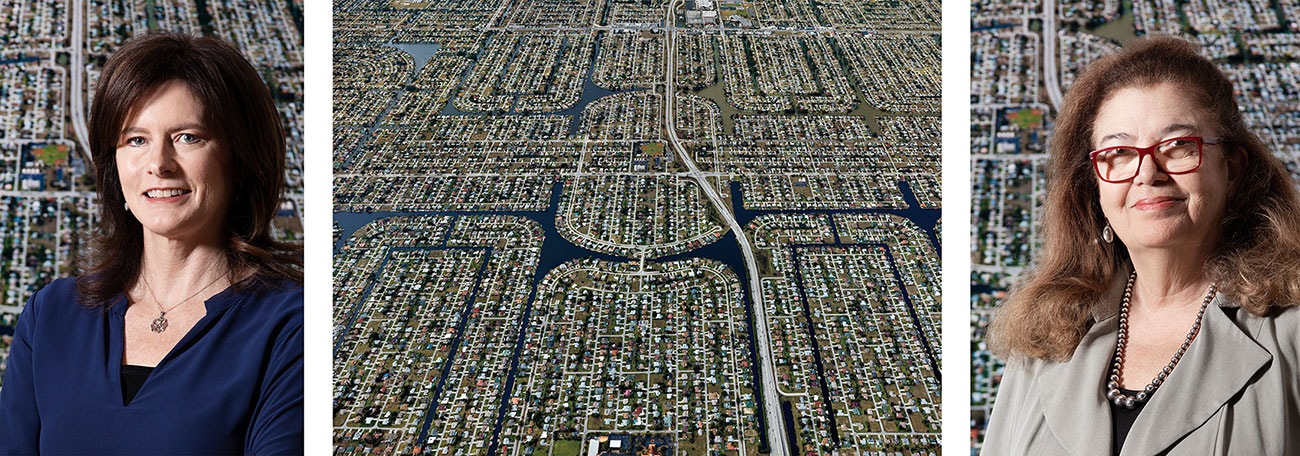 Portrait by Brianne Lehan and Lyon Duong/UF Photography. Artwork: "Cape Coral, Florida #1, 2012" by Edward Burtynsky, 2012, courtesy of Howard Greenberg Gallery, New York
Portrait by Brianne Lehan and Lyon Duong/UF Photography. Artwork: "Cape Coral, Florida #1, 2012" by Edward Burtynsky, 2012, courtesy of Howard Greenberg Gallery, New York
associate professor, UF College of Design, Construction and Planning
professor, UF College of Design, Construction and Planning
Nearly 40 percent of the world’s population lives within 60 miles of a coast. These interdisciplinary architects are reimagining how we co-exist with water.
Cities of tomorrow:
As directors of the Center for Hydro-generated Urbanism, Kohen and Clark envision new types of cities designed to thrive amid rising seas. “We’re in a process that would be mind-boggling to anybody – we’re trying to foresee of the future,” Kohen says. “It is a duty and a privilege of academia, which is not hinged to politics and economics, to go beyond those influences and generate a vision. Not everyone will be accepting of that vision, but I’ve worked in this long enough to know that in 15 years, these ideas will be common ground for many people.”
What do you want people to understand about adapting to rising seas?
Kohen: Some people think we are sufficiently safe without doing anything.
Clark: Or they think that it’s small fixes or small changes need to be done. Martha and I believe that radical, visionary approaches need to take place.
Kohen: We’ve seen this work in the past with visions for New York, or the Tennessee Valley. There have been moments where a visionary outlook was able to get through. But right now, it looks like we are on an incremental, pixelated way of looking at the way forward, a reactive rather than a stronger, proactive long-range vision.
Clark: Exactly. We need to think 70 years ahead, not five to 10 years.
Kohen: Not raising a road one foot. That’s money not well spent.
Clark: The difficulty is getting the people who are stakeholders to believe in it. But with the increase in storms and flooding in South Florida, even developers are talking about it.
Kohen: The science is there. The knowledge is there. The impulse to get it done is what needs to be built up.
Radical visions:
Kohen: One project we’re working on is called the Sea Belt. What is going to happen with all the coastal towers? Are we going to lose 70 stories of real estate because they get their feet wet? We have strategies and proposals to allow them to complete their life cycle, otherwise losses and abandonment and degradation are going to take place.
Clark: One of the things we try to think about is how to use land development strategies we already know – island development, canal communities — but do it in a smarter way. One of the projects we have for Miami Beach is creating new barrier islands which are well built and high, so they become developable and help protect the bay side of Miami Beach. We also have proposals for canal communities along the Miami River to work with the water in established communities and allow people to remain along the Miami River.
What do you want your students to understand?
Clark: What they dream of and what they imagine in school is possible. Sometimes they think the projects they’re working on in class are not having an impact. We try to get them out meeting stakeholders and working on projects in the community so they can see that cities look to academia for ideas. We’re embracing the idea of a land-grant institution. As much as possible, we try to share our work outside of academia. It’s very important to share what’s possible.
Read about Clark and Kohen’s efforts in Puerto Rico’s recovery from Hurricane Maria in this story from Explore magazine.
This is part of a series highlighting people at the University of Florida working to protect our well-being and the health of the planet, paired with works from the Harn Museum of Art exhibition “The World to Come: Art in the Age of the Anthropocene.” See more at ufl.to/theworldtocome.